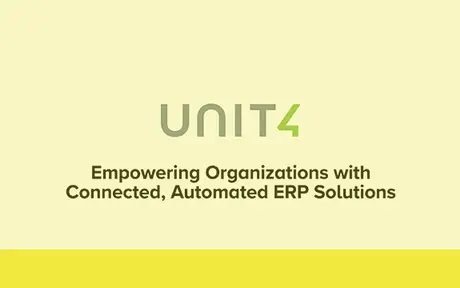What is Business Readiness? Preparing for successful ERP adoption
Digital transformation begins with assessing your business’s readiness, planning how to manage operational changes, and defining clear outcomes that align with your goals.
With the right foundation in place, your organization can do more than just implement a tool but strategically leverage the implementation process to meet your goals and ensure success on all fronts.

In this blog we are going to explore business readiness, how it differs from, and compliments, change management, and why this is vital to ensure you reach the outcomes you need – keep reading to learn more with Unit4.
What is Business Readiness?
Business readiness refers to the process of preparing an organization for the adoption and integration of a new system. This phase evaluates the implementation, and how it can align with strategic goals of adopting a new tool. By focusing on business readiness, you can minimize risk and ensure transformation aligns with business goals.
A business readiness assessment involves engaging stakeholders, engaging teams, and creating clear developing a business case. This preparation not only reduces resistance to change but also ensures the system delivers its intended value across all levels of the organization.
This is a vital step that occurs before implementation, usually alongside vendor evaluation and tools selection.
A business readiness plan focuses on:
-
Evaluating the business’ readiness to implement tools
-
Understanding the processes that need to change, and the outcomes that need to be achieved to define the success of the implementation
-
Talking to your end-users about the changes they need
-
Evaluating the gains and business case for implementation
Sed diam nonumy eirmod tempor invidunt ut labore et dolore magna aliquyam erat, sed diam voluptua. Lorem ipsum dolor sit amet, consetetur sadipscing elitr, sed diam nonumy eirmod tempor invidunt ut labore et dolore magna aliquyam erat, sed diam voluptua. Lorem ipsum dolor sit amet, consetetur sadipscing elitr.

More client focus, less admin? Find out how!
Get a customized demo tailored to the unique needs of professional services firms.
What is Change Management?
Change management is the process of helping teams and individuals adapt to new systems by addressing the human side of change. It focuses on minimizing resistance, fostering adoption, and ensuring smooth integration of new technologies into workflows.
Change management focuses greatly on the end-user, ensuring there are no hiccups once an implementation process has been agreed.
Unlike business readiness, which evaluates an organization’s overall preparedness for digital transformation, change management specifically targets how users can adjust to the transformation successfully. Together, they complement each other by aligning operational readiness with employee engagement, ensuring seamless implementation.
Change management focusses on:
-
Developing a clear communication plan for users, and anticipating hurdles int his process
-
Identifying and addressing potential resistance to the new system
-
Developing training programs to equip employees with necessary skills
-
Creating a feedback loop to monitor and address concerns during the transition, and develop a culture of innovation
Sed diam nonumy eirmod tempor invidunt ut labore et dolore magna aliquyam erat, sed diam voluptua. Lorem ipsum dolor sit amet, consetetur sadipscing elitr, sed diam nonumy eirmod tempor invidunt ut labore et dolore magna aliquyam erat, sed diam voluptua. Lorem ipsum dolor sit amet, consetetur sadipscing elitr.
What is the role of the CIO in assessing business readiness?
CIO’s must assess the organization's readiness for change, you can identify potential roadblocks and develop a plan to overcome them, ensuring a smooth and successful transition to a new system. Ultimately, this evaluation of current processes and blind spots that can be optimized effectively falls on the CIO and their office.
The main gap we see when implementing a new system is a lack of planning on what processes need to be improved or created. This gap occurs because outcomes and success had not been defined, or the organization did not have a business readiness plan. Success hinges on C-suite alignment on tool selection and vendor choice.
Examples of a business readiness assessment:
- Define objectives and goals - Clarify what the implementation aims to achieve and identify specific business outcomes it should support, this involves full stakeholder engagement from end-users to the C-suite.
- Analyze current processes - Review existing workflows to understand inefficiencies and map areas for improvement. Targeted implementations often have the most success.
- Evaluate IT infrastructure - Assess whether your current systems, hardware, and security measures can support the new system. If a new system cripples your operations, success will be hard to reach.
- Audit and cleanse data - Identify, clean, and structure existing data to ensure smooth migration and reliability in the new system. Data migration challenges are a common hurdle that requires planning to avoid.
- Plan change management strategies - Develop a plan to manage organizational changes, address resistance, and provide necessary training when selection is complete.
- Allocate budget and resources - Ensure financial and staffing resources are sufficient to support all stages of implementation, from selection to roll out. Finance teams need a clear budget and financial planning capabilities to do so.
How can Unit4 help you implement ERP successfully?
Implementing ERP can be a complex process, but with Unit4's expertise and innovative solutions, your organization can transition smoothly while unlocking the full potential of Unit4 ERP.
Unit4 combines industry expertise, forward-thinking technology, and a partnership-driven approach to help aspiring organizations implement Cloud ERP systems tailored to their unique needs. With features that adapt to your business rather than forcing change, Unit4 ensures that you stay in control of your digital transformation.
Unit4 doesn’t stop at deploying ERP. Our implementation process emphasizes change management by offering training and communication plans for a successful ERP modernization.
To learn more about Unit4 ERP – read how our customers successfully implemented our solutions, talk to sales or read more about our suite of solutions.
Frequently Asked Questions (FAQs)
What is business readiness in project management?
Business readiness in project management refers to the process of preparing an organization for upcoming changes, such as new systems, processes, or workflows. It ensures all stakeholders, resources, and systems are aligned for a smooth transition.
What is a business readiness checklist?
A business readiness checklist is a tool used to assess whether all critical aspects of a project are ready for implementation. It includes tasks like stakeholder training, system testing, resource allocation, and communication planning. This checklist helps ensure nothing is overlooked, boosting project success rates.
How do you measure business readiness?
Business readiness is measured using key metrics such as stakeholder engagement, system performance, resource availability, and team training completion. Surveys, business readiness assessments, and KPI tracking can provide valuable insights, ensuring the organization is set for a successful project launch.








